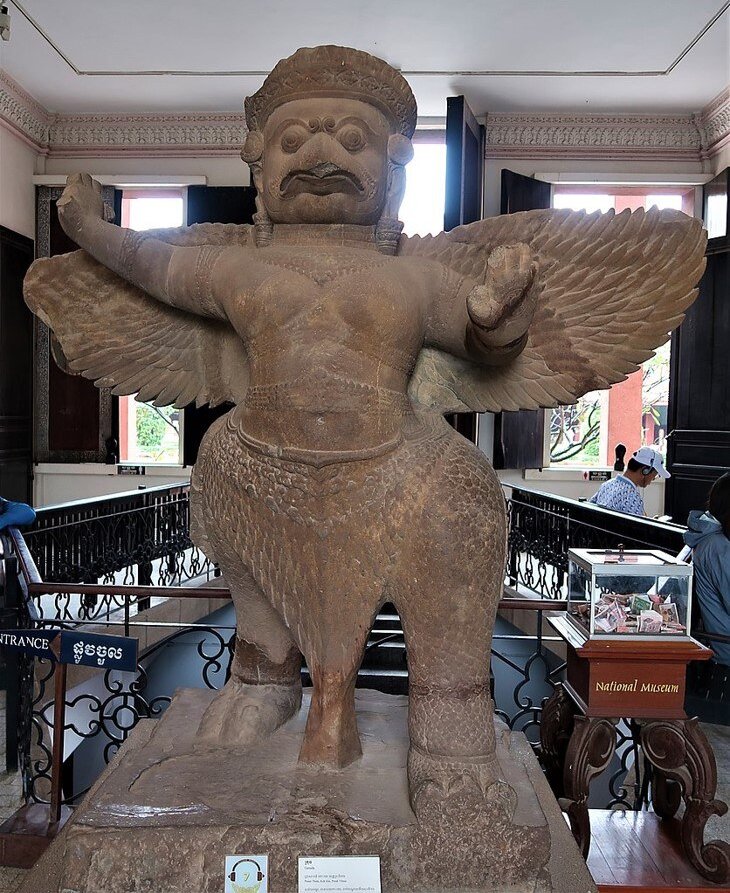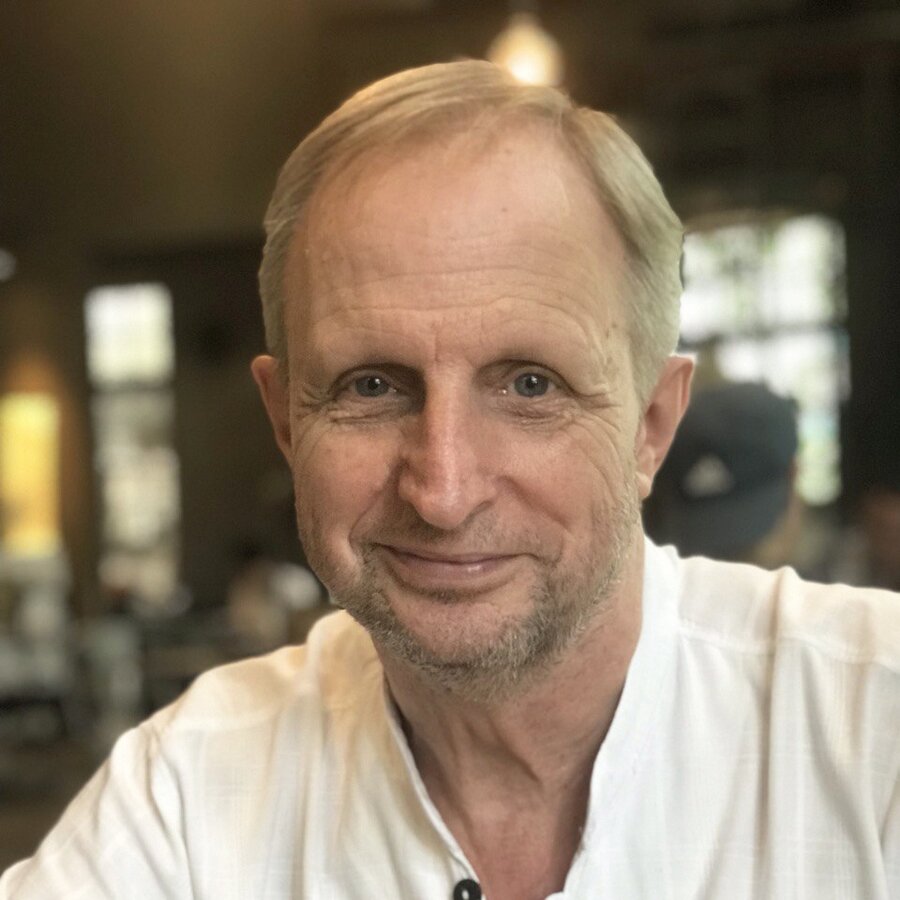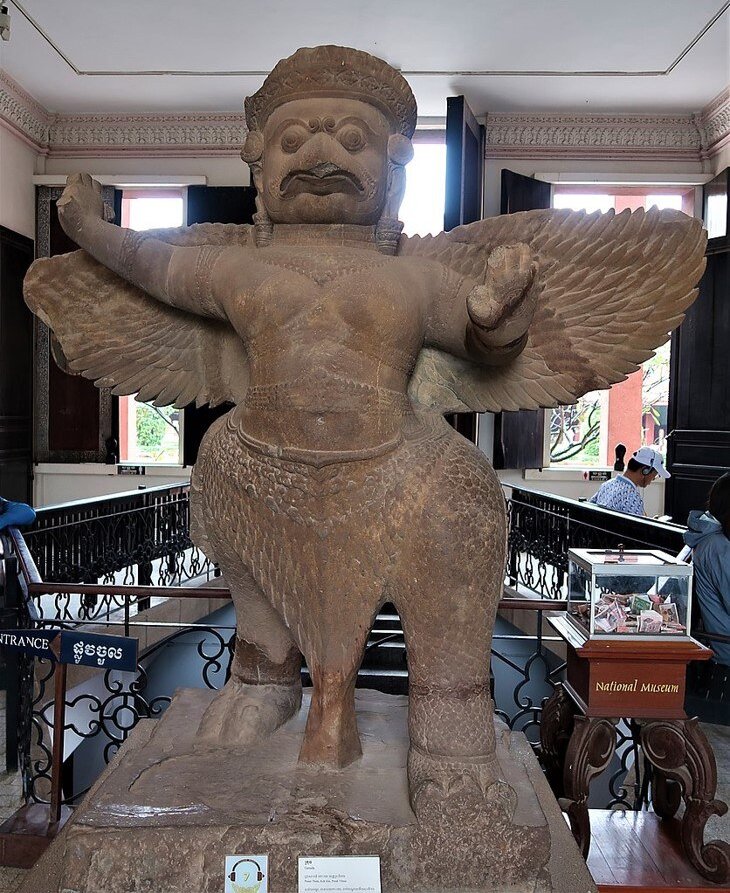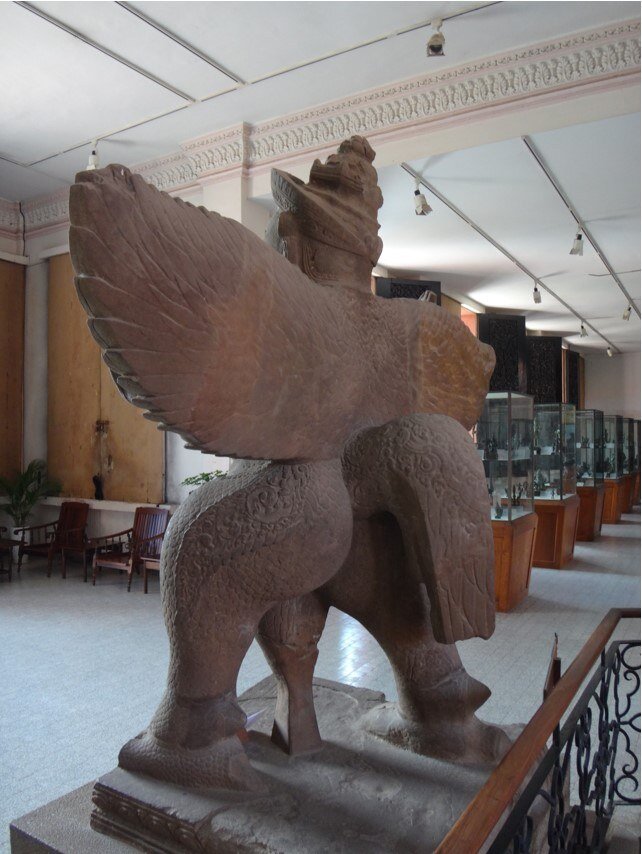The Giant Garuda of Koh Ker
by Andy Brouwer
Entry #1, Khmer Art Worldwide Photo Collection by Andy Brouwer

Published: October 15th, 2021
Author: Andy Brouwer
- Height (cm): 216.5 cm. Sandstone
- 10th century
- Provenance: Prasat Thom, Koh Ker, Preah Vihear Province
- Location: National Museum of Cambodia, Koh Ker Collection, Phnom Penh
- Catalogue Number: NMC Inventory Ka.1737
- Status: Uncontested
- Photo credits: © Andy Brouwer
When you walk through the entrance doors to the National Museum in Phnom Penh, you cannot fail to see the dramatic and imposing giant Garuda from Koh Ker. It’s one of the most remarkable pieces of art in Khmer history and represents the monumental and dynamic energy emanating from the 10th century capital of Koh Ker under King Jayavarman IV. The Koh Ker-era was miniscule in terms of the lengthy Angkor timeline – just twenty-plus years – but the wealth of innovative and powerful sculptures have withstood the test of time and deserve attention and recognition. Fittingly, the museum is focusing on their Koh Ker collection to celebrate their centenary.
Garuda is a half-man, half-eagle vehicle for the Hindu god Vishnu. As a symbol of supremacy, this striding bird-king demonstrates the harmony between power (in its forceful stride) and grace (the slender torso that balances the upraised arms and wings), creating a magical figure of strength and heroism. He is the sworn enemy of the Naga serpent. His image encompasses a large beak, bulging eyes, two strong paws, open wings, a tail and a human body with two arms. The body is adorned with jewelry, bracelets and armbands, the legs are covered with feathers, as are the wings and central pleat, which combined with the legs, acts as the support for this gigantic figure. Remarkably, the right hand indicates the direction of your museum visit, while the left hand blocks any desire to turn right.
The liveliness of this image is complemented by numerous other sculptures from Koh Ker, whether it be the giant wrestling apes or the vigorous athletic warriors, which are also part of the museum’s Koh Ker collection. The sculpture’s home was in the area known as Prasat Thom, just in front of the royal city’s symbolic pyramid, and poised behind Naga balustrades, as if in dynamic pursuit of its traditional foe. There may’ve been four of these enormous statues, but only this one remains intact. It’s no less than seven feet tall and more than six and a half feet wide, and a great example of the expertise of the stone craftsmen of the second quarter of the 10th century.
Archaeological surveys of the Koh Ker temple complex - also known as Chok Gargyar and Lingapura - were made by Louis Delaporte in 1873, Jules Harmand in 1876, Etienne Aymonier in the 1880s and 1890s, by Etienne Lunet de Lajonquiere in 1900, George Groslier in 1923 and then Henri Parmentier in 1924, and again in 1929-30, which included aerial surveys.
We must assume this Garuda was removed for safety reasons in the 1920s – it’s arrival at the museum is not recorded. Other sculptures were extracted from the site during the original French-led surveys of the temples, whilst those that remained were looted in the more modern era of the 1970s. Some of them have been repatriated in recent years, allowing them to join and characterize the Koh Ker collection being celebrated for the museum’s 100th year anniversary.
Tags: Koh Ker, Khmer sculpture, museums, National Museum of Cambodia
About the Author

Andy Brouwer
Cheltenham-born and bred, Andy Brouwer (1959, UK) made his first trip to Cambodia in 1994, and that white-knuckle ride hooked him for life. He upped sticks to Phnom Penh in 2007 after more than thirty years in banking back in the UK to join Hanuman Films.
As well as having a serious obsession in temples, books -- he’s the editor of the guidebook To Cambodia With Love --, and pretty much all things Khmer, he is a lifetime supporter of Leeds United and has an insatiable passion for the music of Steel Pulse and Ennio Morricone. His website relives his numerous visits to Cambodia, and more.
During his time living in Cambodia, he’s been a producer and researcher for Hanuman Films, a product manager at Hanuman Travel, and the media officer with Phnom Penh Crown FC. Since 2020, he developed a personal research, Exploring Khmer Art Worldwide, published as an ongoing series on his Facebook page, that will be soon hosted on Angkor Database.



